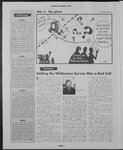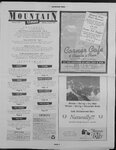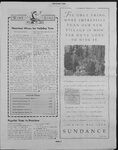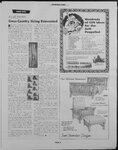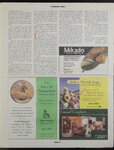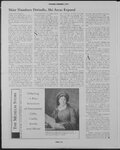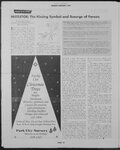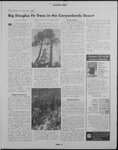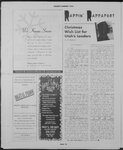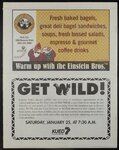| OCR Text |
Show : iy Bh HOLIDAY /JA\ NUARY Pad 1997 MISTLETOE: The Kissing Symbol and Scourge of Forests By Pamela M. Poulson Vianager of Environmental Education Red CC SLL Butte Le rarden Garder Description: Small, slow growing, coral-like shrubs growing on the branches of trees. Stems brittle, forking. Leaves yellow or orangish, leathery and reduced to tiny scales. Fruit green and inconspicuous. Fruit a white or red berry. er he fire lit the room with warm glow. From high in the distance came a mysterious jingle of bells. The tall man had been strategically positioned under the archway to the dining room for nearly fifteen minutes Although many beautiful women had passed by in pursuit of hors d’oeuvres ind wassail, not one had noticed the mistletoe, only inches from his head He pouted, longing for the princess that might offer him a holiday kiss. Abh, mistletoe. The symbol of holiday kissing. The godly icon of Druids The ticket across Styx. The speediest plant on the planet. The killer of Ty What it can be confused with: Witch's Broom, ous” outgrowth of the host plant itself. Range: The majority of species are found in the tropics, but two genera are found in 7S ay x iL Habitat: mighty oaks. The scourge of North American foresters Mistletoes are parasitic shrubs common around the world, and have gained notoriety among many cultures as magical plants. Plants of “neither heaven nor of earth,” mistletoes hang America, centering around California and the southwest, with only one Parasitic on host trees. In Utah, conifers and mesquite trees. Cultural Notes: The most common vehicle duction into the home landscape is through ly. Keep watch for its occurrence, cut it out can be fatal to the host. In the United States Where to see it: Junipers on the trees near St. George are teaming in the vast Pinyon/Juniper forests in all mountain conifer forests of without close inspection. from the berry as far as 48 feet, at an Trees initial velocity of 75 miles per hour! Seeds are also dispersed by berry-eating birds. When conditions are right, the mistletoe seeds germinate, burrowing specialized root-like organs, called haustoria, into the living cambium of their new hosts. Because mistletoes spread easily and weaken or kill host trees, they are a serious cause of low forest productivity in the western United States. To eradicate mistletoes from an area, foresters must keep a constant watch and cut mistletoe from the trees — ridiculous in a 100,000-acre forest of 40 foot conifers. This seemingly impossi- and Boughs Handmade Custom Decorations Gift Certificates Stocking Stuffers Unique and Unusual ble task was in the past achieved by Gift Ideas fire, which burned forests to the ground, but killed mistletoes (and bark beetles.) Species or varieties of mistletoe are sometimes restricted to specific species Corner of Hwy. 224 and Bear Hollow Drive 9a.m. til 9p.m. daily through Christmas Eve Park City Nursery ae “Welcome to the Holidays” a PAGE for mistletoe (and bark beetle) introinfected firewood. Mistletoe grows slowand burn it. In great numbers mistletoe it is illegal to market mistletoe berries. south rim of the Grand Canyon and mesquite with mistletoe. Interestingly, mistletoe is not found of the Uinta Basin, Dwarf mistletoes can be found Utah, but they are small and difficult to detect Phorodendron, suspended in trees. one North American genus, literally means carried (phoro) by a tree (dendron) in classic Greek. Containing little or no chlorophyll, the mistletoe takes structural support, water and nourishment from the host plant. Mistletoes return no benefit, and in sufficient numbers, can be fatal to the host. How does mistletoe gain a roothold? Mistletoe produces one to three seeds embedded in a fleshy, mucilaginous berry. As the berry ripens, hydrostatic pressure builds up within the mucilage to such a high level that the hard shelled seeds become ballistic and literally shoot Cut Christmas 649-1363 North species in the eastern U.S. Eight species with scale-like leaves are found in Utah. No broad-leafed species occur in Utah. It Freshly a which is a malformation or “cancer- like the broad-leaved “kissing” mistletoe, but like tiny fingers or branches of coral. The magical tradition of mistletoe has deep pagan roots. The Greeks considered it a charm against evil and it was used by Aenead to pay for passage across the River Styx. To Druids, mistletoe was second only to oak in magical properties. Romans believed mistletoe to be a symbol of hope and peace. When enemies met under it, they laid down their weapons and kissed one another, declaring a one-day truce. Perhaps the most colorful story of kissing under mistletoe comes from Norse legend: When the sun god Balder told his mother Frigga that he had dreamed of his death, she obtained promises from every living thing that they would not harm Balder. However, Frigga overlooked mistletoe. According to legend mistletoe was a beautiful, long, straight limbed tree. It grew with roots deep into the ground. Loki, god of the underworld, made an arrow of mistletoe and gave it to Hoder, god of winter, who slew Balder. Three days later, at the tearful Was insistence of Frigga, Balder restored to life. To prevent further harm to Balder from mistletoe, it was shriveled to a small, twisted plant and hung in a tree to keep it out of the reach of Loki. Frigga’s tears of joy turned into white mistletoe berries and she kissed each person who came to welcome Balder and passed beneath the mistletoe. of hosts. In most cases the leaves of the Today mistletoe as a magical kiss- specific mistletoe “mimic” the leaves of the host. The broad-leafed mistletoe commonly used for decoration at Solstice, Christmas and New Year's is parasitic on oaks. Of the eight species of mistletoe indigenous to Utah, seven are parasitic on conifers and have tiny scale-like leaves. They look nothing ing device, is often used under false pretenses. According to the Druids, to be potent mistletoe must be harvested by the Arch Druid with a golden knife and captured as it falls within a sacred Druid shawl. The mistletoe must never touch the ground. Kissers are allowed one kiss for each berry. @ 14 |


